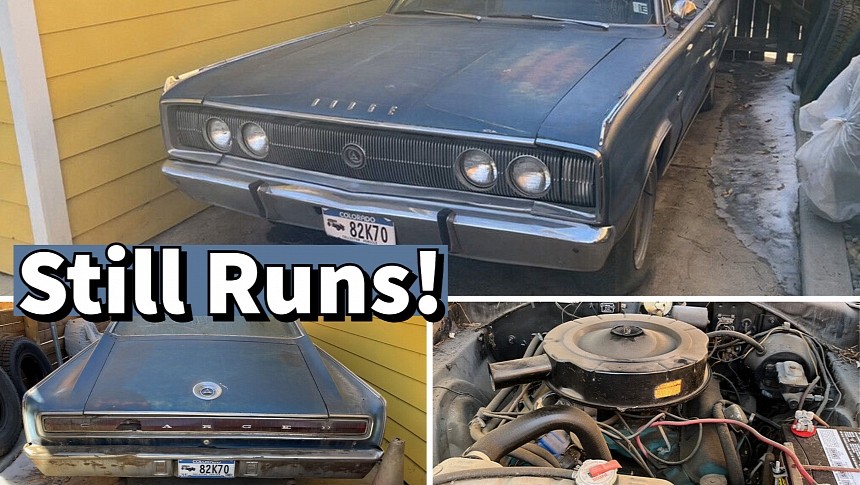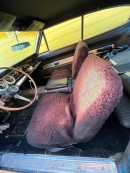Introduced in 1966 as a fastback-styled, more premium take on the performance car segment, the Dodge Charger sold 37,344 units in its first year on the market. Although sales were far below the competition, they were high enough for Dodge to keep the nameplate in production.
The 1967 version arrived mostly unchanged design-wise, with updates including fender-mounted turn signals and an optional vinyl roof. The cabin, however, lost the trademark full-length console, which was eliminated due to customer complaints about difficult ingress and egress to the rear seats.
Dodge replaced it with a regular-sized console but began offering a steering column shifter and a rear bench, which extended passenger capacity from four to five. Despite the changes, sales dropped dramatically to only 15,788 examples. This didn't end the Charger's tenure in showrooms but brought a massive redesign that moved the nameplate away from luxury territory and deeper into the muscle car segment.
Come 2023, and the 1967 version is the rarest iteration of the early fastback Charger. Is it as desirable as the second-gen model that followed? No! Enthusiasts prefer the latter due to its more aggressive styling and high-impact colors. But the 1967 Charger is also a desirable classic when fitted with the right drivetrain combo.
Naturally, the HEMI version is the most sought-after. It's also much rarer compared to 1966. While the first-year Charger spawned 468 HEMI-powered cars, the 1967 version moved only 117 units. Cars equipped with the four-barrel 440-cubic-inch (7.2-liter) RB are also hard to find, with only 660 examples made.
The remaining cars were shipped with 318- and 383-cubic-inch (5.2- and 5.6-liter) mills. And even though they're not necessarily underpowered, these Chargers don't get as much love as the other big-block cars. But while this is terrible news regarding unmolested survivors, it's good news for enthusiasts looking for cool yet affordable muscle cars to restore. The somewhat derelict example you see here is one of those Chargers that may be dirt cheap.
Saved from a junkyard an unspecified number of years ago, this Mopar runs and drives, so it's not just a worn-out classic that's bound to become a parts donor. However, the years it spent in the scrapyard left a big mark as the car lost many of its original parts. The Charger is complete on the outside upon visual inspection, but it has a few issues.
The rear taillight bar is broken, the automatic headlamps no longer work, and the worn-out blue color is not factory correct. There's no VIN, but the seller claims the Charger left the assembly line in gold. This color was indeed available in the car's 1967 color palette as Metallic Gold. And it should have looked identical to this gold-on-gold gem I showed you a while back. Except for the interior, of course, which is black on this model.
Speaking of which, the cabin is in poor condition and missing quite a few bits. The dashboard is incomplete, the radio is gone, and the glove box compartment is empty. The individual rear seats and the console are still in place, but the front seats are damaged and covered in furry and unattractive covers. The odometer doesn't work, so the actual mileage is unknown.
As for the engine, it comes with a 383-cubic-inch V8 of the four-barrel variety. What's under the hood matches the badges on the fenders, but there's no info on whether the mill is numbers-matching. The mill was rated 325 horsepower when new, 55 more than the two-barrel variant of the same engine. Dodge sold 4,840 Chargers with this engine in 1967, so it's not exactly rare, but 383 cars are getting harder to find still in one piece and with running powerplants.
All told this Charger comes with quite a few issues, and the fact that it doesn't have a VIN makes things even worse. But if you're not planning on turning it into a Concours-winning car, it's a solid project for restoration or some sort of hot rod. Especially if the bidding remains low. As of this writing, the highest bid is at only $2,275, with slightly more than two days to go.
Dodge replaced it with a regular-sized console but began offering a steering column shifter and a rear bench, which extended passenger capacity from four to five. Despite the changes, sales dropped dramatically to only 15,788 examples. This didn't end the Charger's tenure in showrooms but brought a massive redesign that moved the nameplate away from luxury territory and deeper into the muscle car segment.
Come 2023, and the 1967 version is the rarest iteration of the early fastback Charger. Is it as desirable as the second-gen model that followed? No! Enthusiasts prefer the latter due to its more aggressive styling and high-impact colors. But the 1967 Charger is also a desirable classic when fitted with the right drivetrain combo.
Naturally, the HEMI version is the most sought-after. It's also much rarer compared to 1966. While the first-year Charger spawned 468 HEMI-powered cars, the 1967 version moved only 117 units. Cars equipped with the four-barrel 440-cubic-inch (7.2-liter) RB are also hard to find, with only 660 examples made.
The remaining cars were shipped with 318- and 383-cubic-inch (5.2- and 5.6-liter) mills. And even though they're not necessarily underpowered, these Chargers don't get as much love as the other big-block cars. But while this is terrible news regarding unmolested survivors, it's good news for enthusiasts looking for cool yet affordable muscle cars to restore. The somewhat derelict example you see here is one of those Chargers that may be dirt cheap.
Saved from a junkyard an unspecified number of years ago, this Mopar runs and drives, so it's not just a worn-out classic that's bound to become a parts donor. However, the years it spent in the scrapyard left a big mark as the car lost many of its original parts. The Charger is complete on the outside upon visual inspection, but it has a few issues.
The rear taillight bar is broken, the automatic headlamps no longer work, and the worn-out blue color is not factory correct. There's no VIN, but the seller claims the Charger left the assembly line in gold. This color was indeed available in the car's 1967 color palette as Metallic Gold. And it should have looked identical to this gold-on-gold gem I showed you a while back. Except for the interior, of course, which is black on this model.
Speaking of which, the cabin is in poor condition and missing quite a few bits. The dashboard is incomplete, the radio is gone, and the glove box compartment is empty. The individual rear seats and the console are still in place, but the front seats are damaged and covered in furry and unattractive covers. The odometer doesn't work, so the actual mileage is unknown.
As for the engine, it comes with a 383-cubic-inch V8 of the four-barrel variety. What's under the hood matches the badges on the fenders, but there's no info on whether the mill is numbers-matching. The mill was rated 325 horsepower when new, 55 more than the two-barrel variant of the same engine. Dodge sold 4,840 Chargers with this engine in 1967, so it's not exactly rare, but 383 cars are getting harder to find still in one piece and with running powerplants.
All told this Charger comes with quite a few issues, and the fact that it doesn't have a VIN makes things even worse. But if you're not planning on turning it into a Concours-winning car, it's a solid project for restoration or some sort of hot rod. Especially if the bidding remains low. As of this writing, the highest bid is at only $2,275, with slightly more than two days to go.













